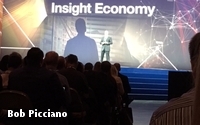 Anyone following the Internet of Things knows that big
data is one of the big deals in it.
Anyone following the Internet of Things knows that big
data is one of the big deals in it.
Of course, there’s the gradual realization that massive amounts of data will be generated by billions of internet-connected devices.
But then
there are the details of how to capture that data, how to process it and ultimately, what it means and what to do with it in a way that actually benefits consumers.
Speaking at the first day
of the IBM Insight 2015 conference here in Las Vegas, Bob Picciano, senior vice president analytics at IBM, pointed out that that 90% of IoT data is never captured, which means it obviously
can’t ever be used.
Though this isn’t the first time this data tidbit has been mentioned, it is worth keeping a constant eye on.
The three-day conference, with several
thousand attendees, is yet again highlighting the role that Iot data will play going forward.
advertisement
advertisement
An additional view of data came from Mike Rhodin, senior vice president of IBM Watson, the
computer system that made headlines courtesy of Jeopardy some time back (Watson won big).
“The majority of data is dark, or invisible to us,” said Rhodin. The efforts around
Watson involve putting information and data into context, as in cognitive systems.
The IBMs of the world are working on figuring out how to capture and analyze the IoT data, even as the amount
available continues to grow exponentially.
Some of the focus is on industrial applications, like machinery for self-diagnosis and preventive maintenance.
But other IoT data will be
used for marketing and advertising. That data could include insights from wearable devices, like fitness trackers, and others from objects and sensors, such as beacons in retail outlets.
The
data ultimately will be captured. The next challenge and opportunity for brands and marketers will be how to leverage that data for new consumer insights that will aid, if not transform,
marketing.
Or as Picciano suggested, an organization will be either a disruptor or be disrupted.